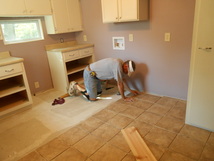Building a house is the perfect example of how the kind and quality of our planning can make all the difference.
Scene 1: You have an idea of what your house should look like but no real blueprints. You've got a lot of friends that will help, so you all gather together for the big event. Let's get started! Everyone agrees to begin by digging a hole in the ground, pouring a foundation, and then each person starts building a room. You walk through the construction noting the progress but wondering if everyone's efforts are fitting together like they should. Some people are making changes that you didn't even know about. There are some unused spaces and some areas that are really cramped. Some rooms are almost done and some have barely been started. Now you wonder how your house is really going to turn out? You "hope" it will look like you wanted it to, when you wanted it to be done... but how will you be sure?
What if there had been a shared vision and then a plan? Maybe just starting from the beginning without a real plan in place is not the best way to build a house. What if you had begun with the end in mind?
Scene 2: You have an idea of what your new house will look like; what will be included; what will not be included; why it will be included (or not); and when it will be done. By having those thoughts, you are indeed beginning with the end in mind. But you realize there are many questions that need to be answered before you can actually start building. What are your goals? What functions or facilities does your new house need to have so that you can live comfortably and efficiently? How long will the building process take? What resources do you need? How will you know the building project is proceeding in a timely and effective manner so the end result will be what you want it to be, when you want it to be done?
So you do your homework, looking around for ideas, asking questions, and prioritizing needs vs. wants. Then you draw a sketch, make a plan, talk to the builder and/or the architect, create a blueprint, and get started building from the bottom up. Revisions occur as unforeseen problems arise or new ideas come to light. But all the revisions are made with the end goal in mind. Checkpoints tell you things are progressing in a timely manner. And the day you open the door to your new home, you are pleased, but not surprised, that it looks exactly as you imagined it would!
*****
Beginning with the end in mind: In an educational setting, this is how curriculum should be planned; units of study should be planned; and even daily lessons should be planned. What is the learning goal? What are the essential questions that promote higher order thinking, inquiry, and deeper understanding? What are the enduring understandings that go beyond the content of the lesson or unit, that apply to the real world? What should students know and be able to do when the learning is completed? How will you know the students have learned what you wanted them to learn? These questions make teachers think beyond assembling day to day, albeit engaging activities. By answering them during the planning process, then delivering them in an engaging and effective manner, learning will be richer and more useful.
Understanding by Design (developed by Jay McTighe and Grant Wiggins) provides a framework for backwards design which is in effect, beginning with the end in mind. This process goes beyond the days of Outcomes, which were also centered around the concept of backwards design (design down, deliver up) where schools established Exit Outcomes (for seniors) and worked their way back to Kindergarten where it would all begin. But UbD takes it a step farther by taking this philosophy into unit and lesson planning, not just system planning.
As schools begin understanding and implementing the Common Core State Standards, UbD becomes a valuable tool in this process. Common Core Standards ask students to be college and career ready: to know what to do with the information and skills they have acquired and when to use those as well. No longer will they just be able to memorize facts or identify specific items. That knowledge is only useful if we know when and how to use it.
Consider the elements of UbD and how they contribute to deeper levels of thinking and understanding:
- Determine the learning goal(s).
- Identify what will be taught (standards).
- What are the enduring understandings (that transfer to other content, situations, and/or real world)?
- What are the essential questions (ones that cannot be answered simply and easily; that require deeper thinking and inquiry)?
- How will we know they have learned "it" (authentic, problem based-assessments that require students to use the skills and knowledge they have acquired)?
- What will we do to accommodate different learning needs, assist students who struggle and provide extensions for those who excel?
- What activities allow for the best learning experiences?
So whether you are building a house, deciding what clothes to wear tomorrow, or educating students, your success depends on focused planning that begins with the end in mind.


 RSS Feed
RSS Feed